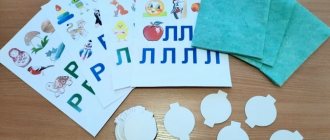"Epidemic" of alalia. How I work with alaliks. From personal experience.
"Epidemic" of alalia.
From the personal experience of a defectologist. How I work with alalik children.
This year, by some coincidence, I began working with non-speaking children of different ages. They bring to me children from two to twelve years old. And we must admit that, looking at a two-year-old baby who not only does not speak, but also does not react to his mother’s calls, almost throws himself in hysterics on the floor, grabs everything and throws things, one becomes afraid for the future of the nation. Sometimes you feel complete powerlessness, as a person and as a teacher. On the one hand, you see, the mother expects that when she comes to the speech pathologist, she will receive a magic pill, and everything with her child will be like everyone else, and on the other hand, you understand that the need to help the child obtain means of communication is broken by his complete reluctance to both -or interact.
I will give examples.
Story one.
Mommy brought a boy to me at two years and eleven months old. The diagnosis is sensorimotor alalia with elements of ASD. The child has a history of a deaf-mute grandfather, and an older brother with a sensory disability. During the first consultation, the child became completely comfortable in the office, scattered all the things he could reach, scattered sand from the light table, and then became interested in animal figures. The kid arranged these figures in a row, one at a time, then chose the largest one for himself, and went on to destroy the office. He accompanied all his actions with incessant interjections and sound complexes that had nothing to do with speech. Its sound was more reminiscent of infant vocalizations. Attempts to attract the child’s attention with toys, appeals, theatrical performances were met with complete indifference on the part of the child, and with more persistent attempts, with a hysterical cry of protest. You might think, what do you want, the child sees you for the first time, he should not react positively to you. But he also either doesn’t pay attention to his mother’s address to him, or screams and throws himself on the floor. During the second lesson, in a conversation with the mother, it turned out that apart from a bun and some berries, the child does not eat anything. Mom can’t persuade him to eat soup, porridge or second course. And if she insists too much, the child responds by vomiting. She even tried, on the advice of experienced people, not to give buns at all, in the hope that when her son got hungry, he would still agree to eat, but no, after three days of the child’s hunger strike, the mother gave up, and from June to October the baby eats only buns with tea and a little blueberries. Of course, she does not give up trying to feed the child healthier and more varied foods, but so far to no avail.
Why did I decide to describe the problem of feeding a baby? And to the fact that even if his own mother cannot convince him to eat, then how should I perform a miracle and force this child to listen to me, interact in some way, repeat the exercises. Yes, of course, many will say, use the play method, but I would like to see how you will play with a child who bypasses you, like some kind of obstacle on the road, preventing him from moving chaotically. The result of our interaction was sad. Mom was not ready to wait, hope and pay for a year or two, or however long it would take, until I managed to establish contact with the baby and persuade him to interact. They simply stopped going to class after the fourth meeting.
The second story.
They brought me a two-year-old baby. Diagnosis: motor alalia, dysarthria. The third child in the family. The first had no problems with speech, the second had dysarthria. Seeing the similarity of the initial symptoms, my mother decided to start working on his speech as early as possible. And here is the cardinal difference - the child understands speech. Yes, he does not speak, he is not assiduous, he has difficulty moving his tongue, intolerance to music and songs, intolerance to attempts at massage, but he understands spoken speech. You can interact with him, you can attract his attention, even for a minute, but still possible. Mom doesn’t expect a miracle, she approaches her classes very responsibly, but the baby gets nervous in the office and gets distracted by everything. Focused attention time is limited to three minutes. As a result, it was decided to meet once a week for 25 minutes. I built the classes according to the principle: I will teach the mother, and she will pass it on to the child. Every time I explain to the mother the next steps in educational activities for the week, if possible we try to do all the exercises experimentally with the baby at least once, then the mother at home, according to the schedule, works with her son for two to three minutes, six to seven approaches a day. The mother came up with the idea of giving the baby a facial massage with a warm towel after bathing, at which time he is ready to tolerate touching his cheeks and lips for a couple of minutes. Mommy makes all the necessary exercise equipment with her own hands. This is how they got bottles with light balls and feather butterflies on strings for breathing exercises; boxes and buckets with slots in the lid, for the development of fine motor skills; pictures – coloring pages on cardboard with onomatopoeias; bags for surprise moments, vision boards. As a result, after a month of lessons, the child began to happily show animals in pictures, onomatopoeize some, correlate two colors - yellow and red, and distinguish a circle from a square. The number of sounds pronounced has increased significantly. This child’s success is greatly due to his responsible mother, who does not expect a miracle, but makes it a daily effort.
Story three.
Girl five years old. Diagnosis: sensorimotor alalia, complete lack of cognitive interest, moderate mental retardation. For a year, I came to class every day for 13 minutes. The child is very sensitive to time and it was not possible to increase it even by a minute during the entire school year. Starting from the new school year, after the summer break, the girl turned 6 years old, and classes were increased to 25 minutes. During the first lesson a year ago, I noted the child’s complete indifference to any toys, things, or pictures. The child had no material desires. If some thing came into the baby’s field of vision, the girl could try to take it or touch it, but with the slightest failure, she immediately lost interest and did not try to repeat it; with a successful attempt, interest was lost after 1-5 seconds. There was no appetite, so food reward was also ineffective. General motor skills are close to normal, but fine motor skills are very behind. Hands are limp, fingers feel like cotton wool. Articulatory movements are limited, the facial expression is old-like, facial expressions were absent. There was no understanding of speech and gestures, with the exception of the phrase “let's go for a walk.” Active speech was represented by one word “gulya,” meaning “I want to go for a walk,” and several sound complexes—vocalizations reminiscent of birds chirping, but not denoting anything. Self-care skills were limited to the ability to go to the toilet without asking, hold a spoon in your hands, and pull off your socks, slippers, and underpants. After a year of daily classes with a speech pathologist in the institution and her mother at home, against the background of drug therapy prescribed by a neurologist, the following results were achieved: the girl understands about 15 everyday phrases, says the word “give”; eats and drinks independently; there was a desire to manipulate toys; the baby learned to put toys into a box, unscrew the lids, build a tower from cubes, assemble a pyramid without taking into account the size; catch a ball; she can carry out instructions such as: take the bag, put your shoes in it, carry the bag, wait for me; but is still not at all interested in pictures, story toys, drawing or any kind of productive activity. Fine motor skills have improved, the quantity and quality of articulatory movements, and the number of sounds in vocalizations have increased. Tasks for this year: teach how to correlate 4 colors, distinguish objects by size, increase the range of instructions and understandable phrases, and force the pronunciation of a few more words.
Story four.
Girl 5 years old. The diagnosis is sensorimotor alalia with elements of ASD. At the time of meeting the child, there was a strong deviation in behavior. The girl screamed, jumped sharply, and then ran screaming, could push any child, tirelessly poured small objects from one jar to another, played with sand for hours. At the same time, she could fold a pyramid and match geometric shapes by size, shape and color. Complete the picture using ready-made modules, for example, add a card with a painted roof to the walls of a drawn house. But to the question: “Where is the girl sitting in the picture and where is she standing?”, the child could not even answer with a gesture. Self-care for a child according to age: eats on her own, goes to the toilet, undresses and dresses with a little help. Parents did not adequately respond to the child’s problems, expecting that everything would go away by itself, they just needed to find the right teacher. Treatment was carried out periodically. At home, behavior was strictly regulated. After a year of daily 20-minute sessions with a speech pathologist, no significant changes were found. Working out at home with mom and dad gave a result that only manifests itself in their presence: the girl can stand and wait for mom and dad while they are busy, she can button and unbutton the buttons on a jacket, give something that is asked for, and do small errands. Echolalia began to appear in the form of individual words, not tied in meaning to the situation.
As a result of these and many other observations, I concluded that many parents, in many cases, expect a miracle from a defectologist, but they themselves are not ready to devote all of themselves to the correction of their own child. Also, parents find it difficult to come to terms with the need for medicinal support for a physically healthy child, not perceiving the problems of intellectual disability, speech and behavior disorders as an indicator for treatment. Therefore, without constant parental support and their regular participation in the correction of the child, achieving positive results is very difficult.
Alalia at school
Work of a speech therapist with alalik children at school.
Currently, alalia is customary to designate a severe speech disorder caused by underdevelopment or damage to the speech areas in the left hemisphere of the brain, which occurred even before the formation of speech, i.e. up to 1-2 years of a child’s life.
However, all classifications of alalia do not exhaust the variety of forms of alalia. Monakov’s statement about aphasia fully applies to this speech disorder: “There is no aphasia, but there are aphasics.” Also, alalik children and the ways of developing their speech functions are infinitely diverse.
This disorder occurs in approximately 1% of preschool children and 0.6-0.2% of schoolchildren. In the process of schooling, children with alalia who have mastered speech may develop a violation of written speech. Reading aloud is usually as difficult as speaking, but sometimes sounds that are easy to produce in spoken language are impaired when reading.
In other words, a child who easily repeats a word when he needs it cannot always pronounce it when reading aloud, even if he understands the meaning of the word. In different children this feature is expressed with varying intensity. There are cases when a child easily reads to himself, that is, understands the written text, but makes serious mistakes when he begins to read out loud.
It is interesting to note that in alaliks, as their vocabulary is expanded, the number of agrammatisms increases, in contrast to their decrease in a normally developing child, as his vocabulary is enriched. The approximate sequence in mastering parts of speech is as follows: noun, verb, pronoun, adjective, numeral, conjunctions and prepositions.
Learning to read and write is usually given to alaliks with great difficulty, requiring extended periods, and yet, up to the 4th-5th grade of a mass school, alaliks can confuse letters, omit and replace them in writing, omit and rearrange syllables in words and words in sentences. Alalik finds it difficult to repeat and remember complex common sentences; therefore, they write dictations worse than expositions.
Reading remains slow and inaccurate for a long time, and oral speech sometimes amazes with turns of phrase that are not characteristic of the native language and resemble the speech of a foreigner. Arithmetic operations are learned more easily than literacy, and solving problems turns out to be difficult, since the student cannot quickly and accurately understand the text of the problems.
In terms of intellectual development, children are heterogeneous. Among them there are those who, having not yet mastered phrasal speech and can barely name the numbers of the first ten, already know how to count and perform arithmetic operations in their heads, showing the results on their fingers. They understand speech well and love to listen to readings, memorize fairy tales and correctly complete all tasks when checking the text they have read. Such children quickly learn letters and master the merging of syllables, but their reading is inaccurate, and paraphasias and agrammatisms persist for a long time in oral and written speech.
Frequently there are motor alics with a pronounced lag in intellectual development (but not oligophrenics). Their learning of speech and literacy proceeds very slowly, hampered by a lack of sustained attention and great fatigue. The difference from oligophrenia is that with alalia we are dealing with focal brain damage, with selective damage to speech function.
Alalik children lack various forms of singular and plural, noun, verb, adjective. The meaning of many prepositions was unfamiliar (prepositions above, behind, from, in front, behind, between).
Work on speech development in children with motor alalia is long and difficult. It requires the speech therapist to have great observation and a thoughtful approach to each child. If we schematize this work, we can divide it into 4 stages, corresponding to the 4 stages of speech development.
1st period of speech therapy work
The main task of the first period of work with alalik children is the creation of a speech impulse through the establishment of a kind of passive (on the part of the child) speech contact. During this period, the speech therapist speaks instead of the child, expressing everything that needs to be said to him and what the child himself wants to say. Development occurs during the game.
2nd period of speech therapy work
The task of the second period is to develop conscious mastery of speech sounds and mastering individual exclamatory and babbling names by imitation. The child learns to imitate individual words and exclamations.
3rd period of speech therapy work
The third period in the work of a speech therapist begins when it becomes possible to memorize names of individual objects and actions that are short for pronunciation and introduce them into the active dictionary. The child begins to develop independently acquired words. At the same time, errors in speech appear:
- Paraphasia (sound replacement, word replacement)
- Rearrangements of sounds and syllables in words
- Contamination - mixing the sound composition of several words and the formation of new words (hammer - hammer)
- Perseverations - repetition of sounds, syllables, words. The dictionary reaches 20-50 words.
4th period of speech therapy work
During this period, the help of a speech therapist consists of teaching literacy, which ensures the child masters the correct structure of words, and later, phrases. The process of learning letters forces the articulation of all sounds to be repeated again, and the letter becomes a new reinforcement of the sound.
Reading and writing are taught in parallel. In case of graphic difficulties, writing with dots is used, tracing the prepared outlines of letters with a colored pencil.
To prevent the rearrangement of letters and syllables when learning to read words, you need to move the pointer from letter to letter, showing the direction of the line.
What do preschool speech therapists need to consider when working with alaliks:
Do not delay the sound production until the preparatory group, since there is almost no time left for individual lessons due to the large number of frontal lessons during this period.
- Pay more attention to the automation of sounds, continuing until the child uses the sound correctly in independent speech.
- After automation, it is imperative to differentiate the sounds already delivered. This will help the future student avoid mistakes with mixing these sounds in writing.
- Focus on the sound analysis of the word.
- Teach your child syllabic analysis and reading syllables.
- Diagnose mental retardation among children with alalia before starting school.
During school training, speech therapists should consider the following points in their work:
1. Work on correcting dysgraphia and dyslexia should be carried out in parallel.
2. Carry out the systematic development of analyzers (auditory, visual and kinesthetic) involved in reading and writing. As an element, it can be included in every frontal lesson.
3. Develop clear articulation of the sounds being studied.
4. Since phonemic perception in children with alalia is almost always impaired, differentiation of oppositional sounds should take quite a lot of time. It happens that speech is phonetically correct, but the child has difficulty differentiating between whistling and hissing, voiced and voiceless, and sonorant sounds.
5. A careful study of the writing errors of such children showed their specificity, based on the insufficient development of sound analysis and synthesis.
Much attention should be paid to working with the split alphabet and syllable cards. When writing, such children make many mistakes by omitting a vowel or one of two consonants with a confluence. Preliminary compilation of a word from a split alphabet, and then a letter with pronunciation according to Betenkova following the preliminary analysis will help us avoid these mistakes. A sound is considered learned when the student can isolate it from any simple syllable and word.
Iotated vowels often create a big problem when they are a sign of softening of the previous consonant (meat, honey, raisins). We do not conduct a sound analysis of them, since in the initial and final positions they break up into 2 sounds.
It is convenient to carry out sound and syllabic analysis using schematic writing:
- Count how many words there are in the sentence and put the same number of horizontal lines.
- Divide the words into syllables and put the same number of small lines.
- Count the number of sounds in the syllables and mark them below with dots.
Lena washed her hands.
____ ____ ____
_ _ _ _ _ _
.. .. .. .. .. ..
6. Work with conjunctions and prepositions can also be done through schematic writing, indicating the preposition with a small line.
7. Since 80% of words in the Russian language cannot be explained by rules, vocabulary words are practiced at each lesson (a speech therapist must have a list of words by grade) and selected to the topic of each lesson.
8. The unit of reading should be a syllable, not a letter. This method ensures smooth and correct reading. Without the ability to perceive a syllable, you cannot move on. It's difficult to teach children to read. if they are going through the letters and cannot see two letters at once.
The techniques and methods of working on activating speech in motor alalitics described here are only a small part of the whole variety of types and methods of working on speech. Considering the importance of speech practice, it is necessary to try to activate children’s speech, linking this with the development of speech understanding. Along with the accumulation of accurate, specific ideas, great importance must be attached to the development of attention to speech, the ability to listen to correct speech.
During the development of speech, alalik children must be placed in various conditions that provide the opportunity to accumulate experience in independent actions. It is necessary to use such methodological techniques that promote comprehension, stimulate the need for verbal communication, the desire to find out something, ask, answer yourself.
Pinchuk M.P., teacher-speech therapist
- Non-speaking child, motor alalia or OHP level I
- Alalia
- 10 problems of a first grader, or why do you need a speech therapist at school?
- Planning the work of a speech therapist teacher in a secondary school
- The role of a speech therapist in developing school readiness for children with severe speech impairments
( 3 liked, average score: 5.00 out of 5)
Loading...






